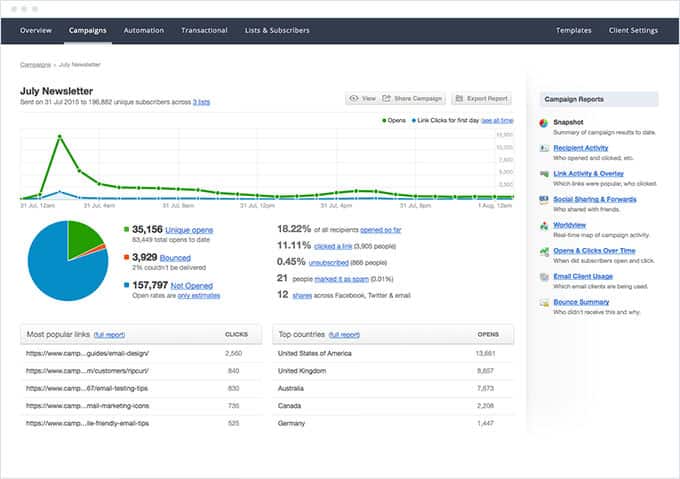If you believe some people, email has been dying for most of its life. And yet here we all are !
Sarcasm aside, the numbers say email is alive and well. The channel remains a staple of the digital-marketing diet because it’s profitable (average of $42 made for every dollar spent on email) and it’s immensely helpful, if not essential, for moving people through funnels.
But of course, there’s a lot of “noise” in email marketing and a lot of confusion around best practices. Compounding the problem: with email, it’s too easy to see statistics and forget that (A) real people receive the messages and (B) the statistics reflect how those people received the messages. So it’s definitely worth pausing now and again to think about email marketing from your customers’ perspective.
Hubspot polled 400 consumers to ask two burning questions: why they opt into marketing email and, on the flip side, why they opt out. We’ll be giving you their answers.
Why Consumers Opt In
Reason № 1: They like saving money. The largest group, roughly 28% of consumers, said their main reason for opting into marketing email was receiving promo codes, coupons, and sale notices. Bear in mind: some customers won’t take immediate action when you send a promo or discount (if they notice at all), but they will be far likelier to buy if it crosses their mind and they find one when they search their inbox.
Reason № 2: They want to see brand content. This is actually the more interesting reason to us. First of all, it’s a close runner-up with 25% of consumers calling it their main reason for opting in. Secondly: when you think about it, this means that consumers want to consume brand content about as much as they want to save money—and THAT is saying something.
Remember that there is some intrinsic meaning to a person’s choice to opt into your marketing emails. In the simplest possible way, it says “I care at least enough to let you send me stuff.” Brand email content is an opportunity to generate more leads, retain more subscribers for longer, and build your authority on key subjects while you deliver value to the people who are predisposed to listen.
Reason № 3: They want to be knowledgeable consumers. The distant-third group (at 16%) is consumers who mainly want brand news and announcements. Combined with brand content, news and announcements are the consumer’s way of “knowing” you for their own benefits, both intrinsic and extrinsic. This reason makes even more sense when you think specifically about the passive benefits of email; it’s a way of receiving information effortlessly, whether you hit Inbox Zero daily or just skim through your infinite pile on occasion.
Why Consumers Opt Out
Reason № 1 and Then Some: They’re getting too many emails. A full 51% of Hubspot’s respondents said that this was their main reason for unsubscribing from marketing email. It’s the biggest reason by far. Seems like a pretty clear message, y’all. We’ll add this for the good of the record: respondents were roughly twice as likely to unsubscribe if they received multiple emails in a day versus multiple emails in a week (34% vs. 17%).
Even if you don’t (think you) send tons of emails, ask yourself:
Is there anywhere you could combine and consolidate emails together?
Where could you smartly segment your list to reduce the message load on each subscriber?
Could you be more transparent with new subscribers about email frequency, or provide different options for email frequency?
Reason № 2: They feel that the emails are spammy or excessively promotional. This might seem a tad confusing… why would “promotional” emails be a problem when promotions are the main reason people sign up?
At root, this is a content problem. Content is what makes your email subscribers feel like they’re human to you, like you have something in common (as people). Subscribers do like sales and promotions, but they’ll feel like statistics if that’s the only reason you talk at them (all the time).
It’s easy to blast your list about a sale—and rewarding to see some money flow in right away—but it’s hard to stop and think, and to send a message that readers will consider valuable for its own sake. That’s why content has never been an easy road. But it’s the closest we come to human connection by email, and it’s those human connections which create lifetime customers.
90% of email gets delivered to the intended recipient’s inbox, whereas only 2% of your Facebook fans see your posts in their News Feed. This is because Facebook limits the number of times your posts appear in the News Feed in an attempt to drive brands towards their paid advertising options.
On Facebook, if you post an update to your 10,000 fans only about 200 of them will even have a chance of seeing it in their News Feed. Alternatively, if you send an email campaign to 10,000 subscribers at least 9,000 of them will receive it in their inbox.▶️ Your message is 45 times more likely to be seen using email than Facebook ✅ !
 If you believe some people, email has been dying for most of its life. And yet here we all are !
If you believe some people, email has been dying for most of its life. And yet here we all are !